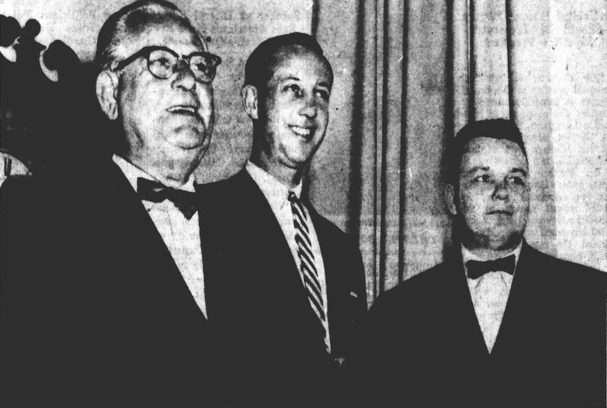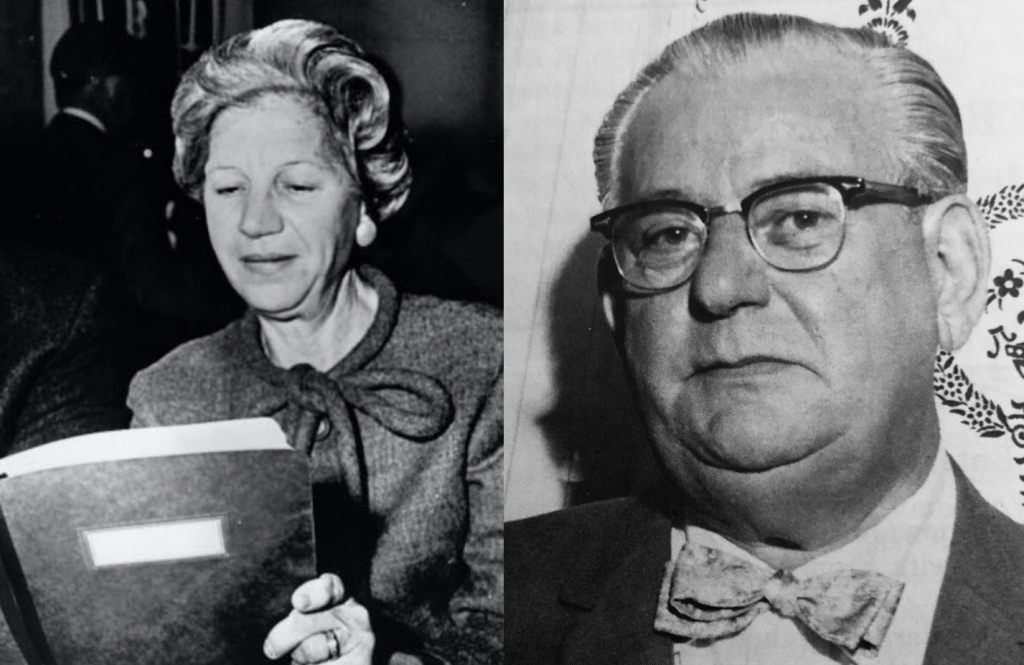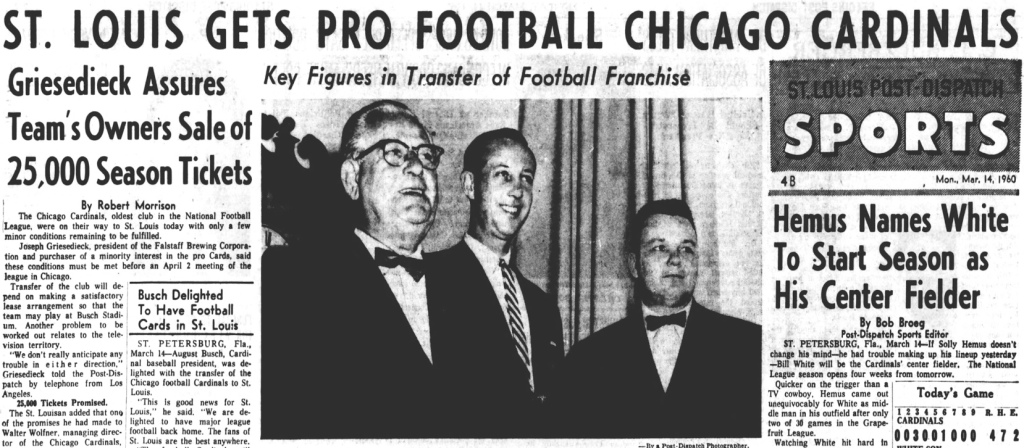Posted by Bob Underwood

The Arizona Cardinals were founded in Chicago as the Morgan Athletic Club in 1898 and were charter members of the National Football League in 1920. During their stay in the Windy City, the Cardinals won a controversial NFL Championship in 1925 and another in 1947, just after team owner Charles Bidwill passed away. After losing in the 1948 Championship game, the Cardinals fell on hard times. They went through a number of head coaches, losing seasons, and were struggling financially.
WALTER WOLFNER
Violet Bidwill had taken control of the team after her husband Charles’ death in 1947. Two years later, Ms. Bidwill married Walter Wolfner, a one-time St. Louis coffee broker. In 1951, Wolfner was named managing director of the team, with Charles “Stormy” Bidwill the president, and Bill Bidwill the vice-president. The fact that Wolfner had control of the team was the first step in the Cardinals moving to St. Louis.

In 1954, the Cardinals would play their first charity exhibition game in St. Louis. They lost 30-0 to the Philadelphia Eagles, but Wolfner would sign a ten-year agreement to play an annual exhibition game at Sportman’s Park. The game would become known as the Cardinal Glennon charity game and it would become a fixture on the Cardinals pre-season schedule for over 20 years.
The Cardinals continued to struggle financially in Chicago throughout the mid-1950s. As Robert Burnes wrote in his book “Big Red,” Wolfner was being badgered by the press and friends to move the team to St. Louis. “We have to do something,” Wolfner said, “The Bears have offered us $500,000 to leave Chicago and we’ve made them the same offer, but it’s a standoff.”
Violet Bidwill Wolfner did not want to leave Chicago. “They tried to run Charley (Bidwill) out of Chicago ten years ago and they couldn’t do it. Now they’re trying to do the same thing and the answer is still no.”
TELEVISION MONEY
Televison was starting to have a great impact on the National Football League. The problem in Chicago was that neither the Cardinals or Bears could have their road games televised when the other team had a home game. This was a significant loss of revenue for both teams and the NFL.
Bill Bidwill told the St. Louis Globe Democrat, “All the other teams were profiting from television and neither of us (Cardinals and Bears) was making a nickel.”
With neither team willing to budge, the league threatened to intervene.
“Commissioner (Bert) Bell was after both of us to do something about it and told us that if we didn’t come to an agreement, he’d step in,” Bidwill said. “The Bears’ argument was that they were the stronger team and had better attendance. Our argument was that we had been in Chicago longer than they had. If anybody should leave, the Bears should.”
While it became obvious that one of the two teams would have to move, there didn’t appear to be a quick resolution.
EXPANSION
In September of 1959, Commissioner Bell had announced plans to expand the NFL. He singled out St. Louis, Minneapolis, Dallas, and Miami as possible locations.
St. Louisan Joseph Griesedieck, president of Falstaff Brewery, immediately put up $50,000 toward obtaining an expansion team and urged city leaders to expedite plans on a new downtown St. Louis stadium. There was league-wide support for St. Louis expansion and the bid was quickly approved by the NFL in December. There appeared to be no obstacles. St. Louis would have its football team. However, the league backed off at the last minute. Commissioner Bell had suddenly died a few weeks after the expansion announcement and the league was struggling to name a replacement. On January 21, 1960, assistant commissioner Austin Gussell decided to delay expansion until a new commissioner was in place.
It may have been the first, but certainly not the last time St. Louis was left disappointed with an NFL expansion decision.
AFL INTEREST IN ST. LOUIS
On the same day Gussell had announced the expansion delay, a representative of the American Football League appeared in St. Louis to explore locating a franchise in the Gateway City. DeWitt Moyer told the St. Louis Post Dispatch that he was certain St. Louis could be granted the last AFL team that would start play that fall. He even floated a possible team name of the St. Louis Blue Jays.
This development made the NFL nervous. They didn’t want to lose the St. Louis market to the AFL. Chicago Bears owner George Halas, Wolfner, and Griesiedieck resumed talks that would relocate the Cardinals from Chicago to St. Louis. “The league wanted no more tarrying on the television problem,” Bill Bidwill said. “Somebody had to leave Chicago.”
Halas offered to pay the Cardinals $500,000 over a ten year period if they were to relocate to St. Louis. Griesedieck offered to pay Wolfner $300,000 for a 10% stake in the team. Despite continual public denials of relocation by Wolfner, he privately agreed to the terms and planned to request permission to move the team at the upcoming league meetings in Los Angeles.
ANNOUNCEMENT OF MOVE
The NFL met in Los Angeles on March 10, 1960 and Rams general manager Pete Rozelle was finally named the new commissioner. Griesiedieck and Wolfner met with Rozelle to discuss the relocation and on March 13, after a unanimous vote, it was announced that the Cardinals were being moved from Chicago to St. Louis.
Approval of the move was provisional based on Wolfner’s ability to arrange a suitable lease for Busch Stadium and work out satisfactory arrangements for telecasting rights. Commissioner Rozelle gave an April 2 deadline for the transfer of the team to become effective. Both conditions were resolved prior to the deadline.
Wolfner denied the team was moving all the way up to the announcement. When asked if he were moving the Cardinals on March 11, he said “Someone is always trying to move us somewhere. There’s nothing to it. We’re staying in Chicago.”
Two days later, St. Louis had their football team.



I sure do miss the big red to bad they left maybe Saint Louis will receive a expansion team . I really miss pro football in my hometown.
LikeLiked by 1 person
Pingback: Big Red Legends: John David Crow | THE BIG RED ZONE
My uncle used to love the Chicago Cardinals and talk about everything in this article but said the bottom line was halas drove the Cardinals out of Chicago he used to say.
LikeLike
Because of the new television contract, one of two teams had to go and there was no way it was going to be Halas! He didn’t treat Violet Bidwill very well after she married Wolfner and he knew Wolfner didn’t know what he was doing.
LikeLike
Still love the Cardinals and can’t stand the Bears.
LikeLiked by 1 person
And now the Bears are moving out of the city!
LikeLike
My grandfather was a Chicago Cardinals fan because Jim Thorpe played for the team.
LikeLike
Article “forgot” to mention that when the Cards played the 1960 season in Soldier Field, it was Chicago Park District turf, so no alcohol was allowed for sale at the games.You kinda’ knew that couldn’t last, and the District didn’t change their rules. Was fun sitting right behind the team seating benches at ground level. Both teams were side by side in a long row on the west side of the playing field, with their legs dangling into trenches dug out of the turf. I was 17 and felt like I was sitting right with the team! Almost got run over one time by Jim Brown-Cleveland Browns- when he was blasted out of bounds. That’s my NFL! Bing
LikeLike